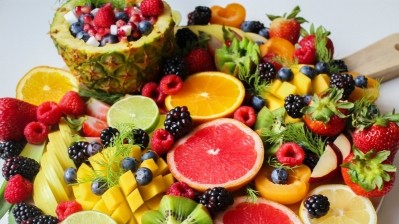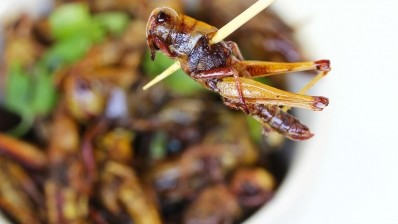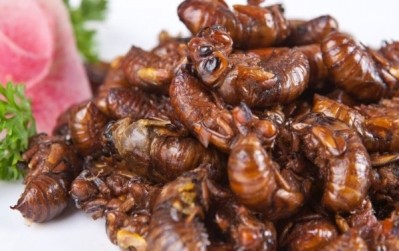Six-legged superfood: Beyond the protein

Crickets, for example, contain 15% more iron than spinach, more omega-3 than salmon and are rich in a number of vitamins and other minerals. Insects should be seen more as a superfood than just a six-legged protein fad.
The best known of these in Western terms—crickets and mealworms—are farmed and most likely to be used as foods in Europe and North America, albeit in markets where they are permitted for human consumption.
But all bugs can boast a nutritional profile that will make dietitians and nutritionists very happy.
For example, all edible insects are rich in fibre, which comes from the chitin in their exoskeletons. The locust, which is 27% fibre, is the top source in this regard. The Swiss government even recognised this when it approved the insect as a food recently.
Moreover, bugs usually contain “good fats”, sometimes in high quantities. As FoodNavigator pointed out: “Insect oil is something like a halfway house between vegetable and animal fat. It is neither as saturated as animal fat nor cholesterol-free like vegetable oil.”
Its composition includes precious essential fatty acids, such as oleic, linoleic and linolenic acids. Though some bugs, especially in the larval stage, reach up to 60% fat in dry matter, the most commonly eaten are in a lower ranges of 10-30%.
When dry, crickets contain 24% fat, mealworms 19% and silkworms 32%. The oil from silkworms, incidentally, which is already a commercial product in some countries, is composed of 29% saturated, 28% monounsaturated and 43% polyunsaturated fatty acids, with a predominant presence of the healthy linolenic acid at 36%.
“Silkworm pupae could be an excellent lipid sure for humans,” one Japanese study concluded.
So what about minerals? Edible bugs are often packed with zinc, potassium, sodium, calcium, phosphorus, magnesium, manganese and copper. Most boast equal or higher iron content than beef, relative to their size, which makes them very useful when the Food and Agriculture Office of the United Nations points out that iron deficiency is the world’s most common and widespread nutritional disorder.
Moreover, crickets are high in copper, iron, potassium and calcium, and the same is the case for mealworms, which also have good quantities of zinc and selenium.
Much has been said about the quantity of protein insects contain, and this is true—a dried cricket can be as much as 67% protein. But less is written about the quality of this protein: a 2005 study identified the presence of all the essential amino acids in the recommended ratios.
And let’s not forget the vitamins present in most edible insects: vitamins B1 and B2, for example, as well as B12 in some species like mealworms (0.47μg per 100g) and crickets (5.4μg per 100g). Vitamin E is present in the palm weevil larvae—a delicacy in Thailand—and in silkworm powder (9.65mg per 100g).
Considering about 670,000 tons of silkworm pupae are farmed annually as a byproduct of the silk industry, though most is not consumed, we may have underestimated what we can do with such a superfood.
Is there a chance for insects to get the recognition they deserve as a healthy and sustainable source of food and nutrition? A number of international market analysts have bet on it, with some projecting the bug food market to be worth US$500m-1.5bn within the next 4-6 years.
The expected growth of insects as an alternative, healthy meat largely has its roots in concerns related to the widespread consumption of bigger animals and sustainability.
As American consumers now go through a record average of 48kg of red meat (without bones) a year, some studies have blamed this form of protein for the increasing prevalence of noncommunicable diseases, including cancer, among Western consumers.
Meanwhile, imports of beef and veal have grown tenfold to 825,000 tonnes in the last five years to China, where policymakers now aim to reduce red meat consumption by 50%. Although this is not yet being enforced by law, it might well be soon.
At the same time, some governments, including France, Denmark and South Korea, have been funding research and development for edible insects, indicating clearly that the food taboo regarding eating insects is not an obstacle even for policymakers, who are often cautious when a topic is sensitive for public consumption.
Of course the “yuck factor” is still a question mark for future consumer acceptance. At the moment, the number of processed food with insects as an ingredient is still pretty low. If we exclude energy bars, which are aimed at the fitness market and usually contain just 3-6% bug content, there remain less than a dozen innovative insect foods that can be classified as potential consumer packaged goods for global markets.
These include One Hop Kitchen bolognese sauce from Canada, my own Bugsolutely cricket pasta, Bitty cookies and Six Food chips from America, and Damhert packaged meat products, which include schnitzel, meatballs, burgers.
Food tech investors be advised: there is room for creativity and food engineering in this segment, and substantial opportunities when the product is acknowledged as a superfood.
- Massimo Reverberi is the Italian founder of Bangkok-based Bugsolutely , which manufactures pasta from cricket flour.

















